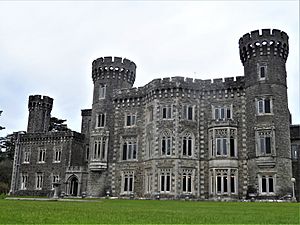Johnstown Castle facts for kids
Quick facts for kids Johnstown Castle |
|
|---|---|
| Native name Irish: Caisleán Bhaile Sheáín |
|
 |
|
| Type | Castle |
| Location | Johnstown, Murntown, County Wexford, Ireland |
| Built | late 12th century (original building) 1836–1872 (current building) |
| Architectural style(s) | Gothic Revival |
| Owner | Irish Heritage Trust |
| Lua error in Module:Location_map at line 420: attempt to index field 'wikibase' (a nil value). | |
Johnstown Castle is a beautiful old castle in County Wexford, Ireland. It was built in a special style called Gothic Revival. This means it looks like castles from the Middle Ages, but it was actually built much later. Today, it's a popular place to visit!
Contents
Where is Johnstown Castle?
Johnstown Castle is found on a large estate that covers about 150 acres. That's like 113 football fields! It's located near the towns of Murntown and Rathaspeck. The castle is about 5.5 kilometers (or 3.4 miles) southwest of Wexford town.
A Look at Johnstown Castle's Past
The First Castle Builders
The very first castle here was a tower house. It was built a long, long time ago, in the late 1100s. A family called the Esmondes built it. They were Normans who came to Ireland from England in the 1170s. This was after the Norman invasion of Ireland in 1169. The Esmondes also built another tower house nearby, which you can still see today.
A Visit from Oliver Cromwell
In 1649, a famous leader named Oliver Cromwell stayed on the estate for a night. This was before his army went on to attack Wexford town. His soldiers used the land around Johnstown Castle to get ready. The Esmonde family, who owned the castle, had to leave during this time.
The Grogan Family Takes Over
The Grogan family bought Johnstown Castle in 1692. One owner, Cornelius Grogan, was involved in the 1798 Rebellion. This was a big uprising where people fought for more freedom in Ireland. After the rebellion, the estate was given back to Cornelius's brother, John Knox Grogan, in 1810.
John Knox Grogan and his son, Hamilton Knox Grogan-Morgan, are the ones who created the Johnstown Castle we see today. They built the new castle on the foundations of the old Norman tower house. A designer named Daniel Robertson helped create the castle's Gothic Revival look. He also helped design parts of the land around it. The main building work on the castle was finished between 1836 and 1872.
By 1863, the estate was split into two parts. There was a deer park (a place for deer to live) in the north. To the south, there was the castle, beautiful gardens, a farm, and two artificial lakes (lakes made by people).
Later Owners and Public Opening
Later, the Grogans married into another old family called the FitzGeralds.
During the First World War, airships from the Royal Naval Air Service were kept at Johnstown Castle. These airships tried to find and stop enemy submarines, but it was a very difficult task.
The last person to live in the castle was Lady Maurice FitzGerald. She lived there until 1942.
In 1945, a man named Maurice Victor Lakin gave the entire estate to the Irish government. This was done instead of paying taxes. Since then, the castle has been used for different things. For many years, it was used for agricultural research by an organization called Teagasc. The castle itself held offices and laboratories.
In 2019, Johnstown Castle finally opened to the public! Now, everyone can visit and explore this amazing place. The Irish Heritage Trust helped to save and restore the building, making sure it stays beautiful for years to come.
In 2007, a temporary opera house was even set up at the castle. It was used to host the Wexford Festival Opera, a famous music event.
Exploring the Castle
-
The lake with beautiful rhododendron flowers
Johnstown Castle is a four-storey building designed in the Gothic Revival style. Inside, you can find many interesting things. There's a special room called the "Apostles' Hall" with detailed wood carvings of saints. You can also see old oil paintings, carved oak benches, and fancy mahogany billiard tables. There are also old dressing tables, comfy sofas, and beautiful fire grates made of brass.
One cool feature is a long tunnel that runs under the ground. It's about 86 meters (or 282 feet) long! This tunnel was used by the servants to get from the meat house to the kitchens without being seen.
The old stable yard, where horses used to be kept, now houses the Irish Agricultural Museum. Here, you can learn all about farming and how it has changed over time in Ireland.






